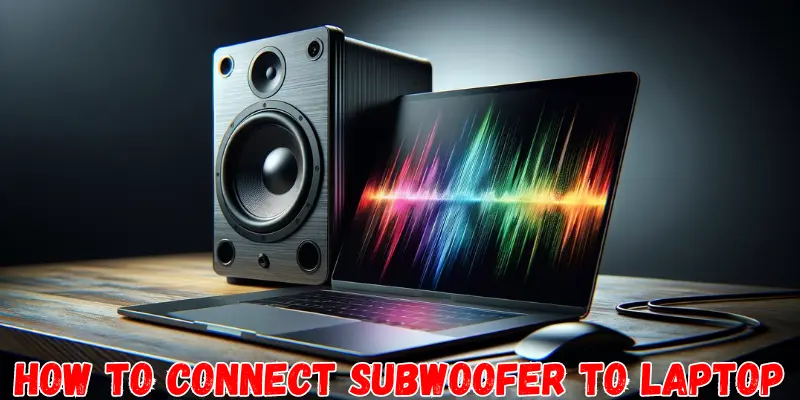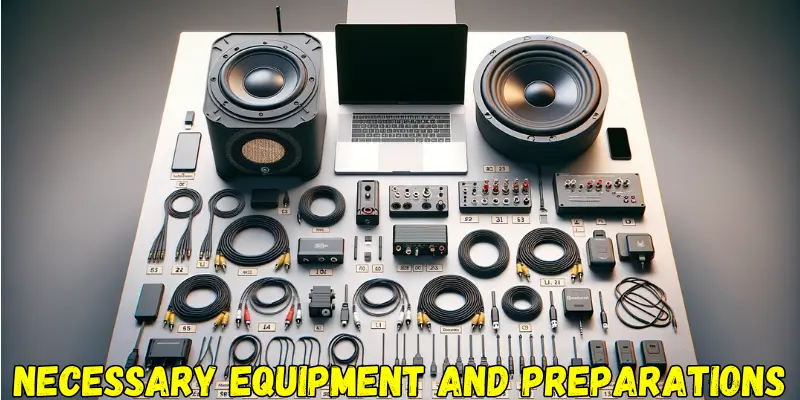
Enhancing your laptop’s audio setup can dramatically transform your multimedia experience, whether it’s for gaming, watching movies, or just enjoying music with a richer sound.
If you’re pondering How to Connect Subwoofer to Laptop, you’re on the right track to achieving audio bliss. Connecting a subwoofer to your laptop can seem daunting at first, but it’s a straightforward process that can significantly boost your audio quality.
In this article, we’ll guide you through the essentials of connecting a subwoofer to your laptop, ensuring compatibility, and optimizing your setup for the best sound experience.
Whether you’re a tech novice or just looking for a quick refresher, our step-by-step instructions will help you seamlessly integrate a subwoofer with your laptop, enhancing your audio setup to levels you might not have imagined possible. Let’s dive into making your laptop’s audio truly remarkable.
Can I Connect a Subwoofer to Laptop?

Absolutely, you can connect a subwoofer to your laptop! This is great news for anyone looking to enhance their laptop audio system for a more immersive sound experience.
Whether you’re aiming to amp up your gaming sessions, dive into movies with deeper audio depth, or simply enjoy your music with that extra bass punch, connecting a subwoofer to your laptop is a game-changer.
Before you get started, it’s important to know that while most laptops are designed with built-in speakers, these often lack the low-frequency response that a subwoofer can provide. This is where the magic of adding a subwoofer comes in. However, to ensure a smooth connection, you’ll need to check a couple of things:
Once you’ve got the right setup, connecting your subwoofer to your laptop can be as simple as plugging in a pair of headphones, with a few extra steps to adjust settings for optimal sound. We’ll guide you through these steps in detail later in this article.
So, yes, you can definitely connect a subwoofer to your laptop, and doing so can transform your audio experience. Stay tuned as we walk you through the process, ensuring you get the most out of your enhanced audio setup.
Understanding Subwoofers and Laptops Compatibility

When you’re looking to elevate your laptop’s audio capabilities, adding a subwoofer into the mix is a fantastic way to go. Subwoofers are designed to reproduce low-frequency sounds, or bass, which your laptop’s built-in speakers might not effectively deliver.
This enhancement can make a world of difference in your listening experience, bringing depth and richness to music, movies, and games.
The Role of Subwoofers in Sound Enhancement
Think of a subwoofer as the backbone of your sound system. While your laptop’s speakers handle the higher frequencies (the treble), a subwoofer takes care of the lower end (the bass). This division of labor allows each component to excel in its range, resulting in clearer, more dynamic sound.
Whether you’re watching an action-packed film or listening to a bass-heavy track, a subwoofer can bring those deep tones to life, making you feel like you’re in the heart of the action.
Compatibility Considerations
Now, you might wonder, “Can any subwoofer work with my laptop?” The good news is, with the right equipment and setup, most subwoofers can connect to any laptop. However, there are a few things to keep in mind:
While most laptops and subwoofers can be compatible, ensuring you have the right connections and considering the type of subwoofer you have (or plan to purchase) will make the setup process smoother.
This insight allows you to approach the task with confidence, knowing that you’re well on your way to experiencing your media in a more immersive and satisfying way.
How to Connect Subwoofer to Laptop?
Necessary Equipment and Preparations to Connect Subwoofer to Laptop

Connecting a subwoofer to your laptop is a great way to enhance your audio experience, whether you’re jamming to your favorite tunes, watching movies, or immersing yourself in video games. Before diving into the setup, let’s ensure you have everything needed for a smooth and successful connection.
Equipment Needed to Connect Subwoofer to Laptop:
Pre-setup Considerations for Connecting the Subwoofer to Laptop
By gathering the right equipment and considering these pre-setup tips, you’re well on your way to connecting your subwoofer to your laptop. This preparation not only makes the actual setup process smoother but also ensures you’ll be enjoying richer, deeper sound in no time.
Step-by-Step Guide to Connecting a Subwoofer to a Laptop
Connecting a subwoofer to your laptop might sound like a task for a tech wizard, but trust me, it’s something you can do too! Let’s break it down into simple steps, ensuring you get that booming bass without any fuss.
Checking Laptop and Subwoofer Ports
Selecting the Correct Cable or Adapter
Connecting the Subwoofer to the Laptop
Configuring Laptop Settings for Optimal Sound
And there you have it, a straightforward guide to hooking up your subwoofer to your laptop. By following these steps, you’ll be all set to enjoy a significantly improved audio experience, whether you’re kicking back with your favorite album or getting lost in the latest blockbuster. Remember, the key is to take it one step at a time, and before you know it, you’ll have achieved audio nirvana.
Troubleshooting Common Issues When Connecting Subwoofer to Laptop

So, you’ve followed all the steps to connect your subwoofer to your laptop, but something’s not quite right. Maybe there’s no sound, or what you’re hearing is far from the rich, clear audio you were expecting. Don’t worry! Let’s walk through some common issues and solutions to get your audio setup working perfectly.
No Sound
Distorted Sound
Verifying the Connection
If after these steps, you’re still facing issues, it might be helpful to consult the user manuals of your laptop and subwoofer or reach out to their customer support. Sometimes, specific configurations or compatibility issues might require a more detailed look.
Remember, setting up a subwoofer with your laptop is about enhancing your audio experience. With a bit of troubleshooting, you’ll be all set to enjoy your favorite content with the rich, deep sound you were looking forward to.
Ready to elevate your home theater experience? Dive into our expert guide, Best Subwoofer Setting for Home Theater, where we reveal the secrets to achieving that perfect, immersive sound. Trust us, your movie nights will never be the same again!
Conclusion: How to Connect Subwoofer to Laptop
Connecting a subwoofer to your laptop is a straightforward journey that leads to a destination filled with rich, immersive audio experiences.
Whether you’re diving into your favorite music playlist, watching a blockbuster movie, or getting lost in the world of video games, the depth and clarity a subwoofer adds to your laptop’s sound can truly transform your entertainment experience.
We’ve walked through the essentials together—from understanding compatibility, gathering the necessary equipment, to making the actual connection and fine-tuning settings for optimal sound.
Remember, the key steps involve checking your laptop and subwoofer ports, selecting the correct cable or adapter, ensuring everything is properly connected, and adjusting your laptop settings to embrace the full potential of your subwoofer.
Now, it’s time for you to explore and enjoy. Experiment with different audio settings, play around with subwoofer placement, and see how it changes your listening experience. You might be surprised at how much more engaging your audio can be with just a few tweaks.
We encourage you to dive into this enhanced audio journey with your laptop and subwoofer. The world of sound is vast and wonderfully diverse. With your new setup, you’re well-equipped to explore it to the fullest.
Enjoy the depth of music, the excitement of movies, and the immersion of games in a way you might never have before. Here’s to your enhanced audio experiences—may they bring you endless joy and satisfaction.
FAQs: How to Connect Subwoofer to Laptop
Can I connect my laptop to an amplifier?
Yes, you can connect your laptop to an amplifier using an audio cable, typically a 3.5mm to RCA cable, or via a digital connection like USB if the amplifier supports it. This setup allows you to amplify your laptop’s audio for a louder and richer sound experience.
How do I connect my laptop to my sound system?
To connect your laptop to a sound system, you’ll need the appropriate audio cable—usually a 3.5mm audio cable or a 3.5mm to RCA cable, depending on your sound system’s input options. Connect one end of the cable to your laptop’s headphone jack and the other to the audio input on your sound system. Adjust the volume on both your laptop and sound system accordingly.
Can I connect a subwoofer directly to PC?
Yes, if the subwoofer is an active type (with a built-in amplifier), you can connect it directly to your PC using an audio cable, typically through the PC’s headphone or subwoofer output port. For passive subwoofers (without a built-in amplifier), you’ll need an external amplifier between your PC and the subwoofer.
Can you connect a speaker to a laptop?
Absolutely! You can connect a speaker to a laptop via a wired connection using an audio cable (often a 3.5mm jack) or wirelessly using Bluetooth, if both the laptop and speaker support it. This is a simple way to enhance your laptop’s audio output for music, movies, and more.






